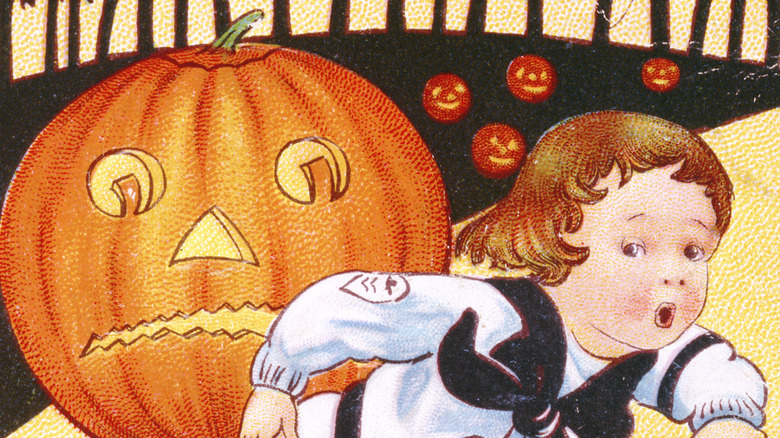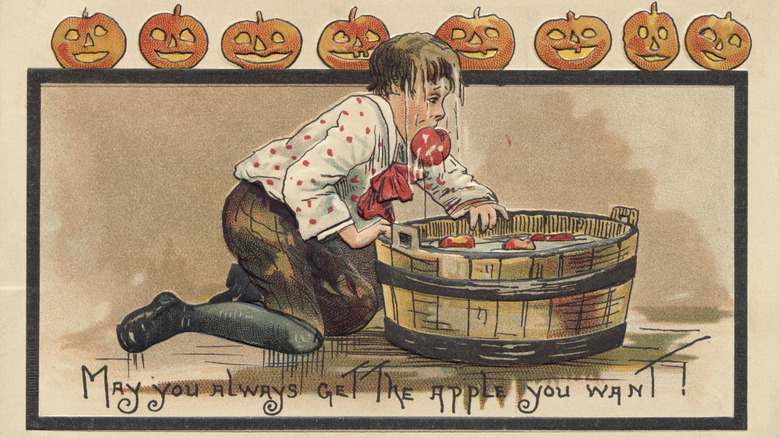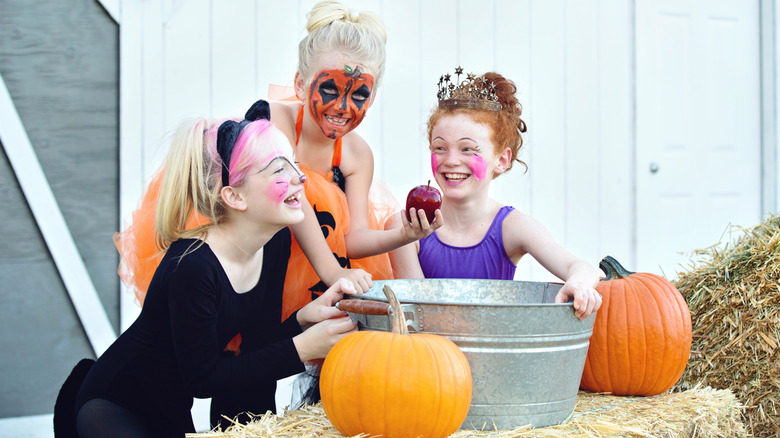Here's What People Ate On Halloween Long Before Candy Reigned Supreme
Whenever Halloween rolls around, there's so much candy on store shelves that it's impossible to miss. Candy is certainly a quintessential part of the holiday now, but that wasn't always the case. While Halloween folklore does have a history of witches cooking and eating children, the actual original preferred treat was far less gruesome. Instead of candy, fruit and nuts — particularly apples and chestnuts — were a customary part of Halloween for hundreds of years.
The original popularity of apples and nuts came from spiritual beliefs by Celtic peoples 2,000 years ago during their festival called Samhain. Giving food to guests or the needy supposedly ensured prosperity for the coming year, so fruit and nuts were offered as gifts. As times changed, apples and cracked nuts hung around, becoming sweetened with sugar or dipped in toffee. These sugary and nutty confections gave Halloween a reputation as a time for sweets, even though candy wouldn't become popular until the 1900s.
As for why things changed, the emergence of mass-produced candy meant that giving out sweets was much easier and cheaper. By the end of World War II, the term "trick-or-treat" was becoming a steadfast part of the holiday, and apples and nuts fell out of favor. Of course, these foods still shape many of our traditions, even today.
Why fruit and nuts were all the rage for Halloween
Halloween has gone through many changes over the centuries. For example, jack-o-lanterns didn't start out as pumpkins — they were originally turnips. But even in its earliest days, Samhain involved offering food to visitors. While we don't know much about the holiday's earliest pagan traditions, we do know that baked, candied, and raw apples or nuts often made appearances at gatherings. According to lore, evil spirits would spit on apples as well as other fruits, such as blackberries, on the night after Samhain, so these had to be harvested before then. Apples, in many ancient traditions, provided good fortune or even allowed you to see the future, so it made sense that they were popular to eat during Halloween.
This fruity tradition persisted and eventually came over to the United States. During the mid-1800s, certain regions began celebrating what was called Snap Apple Night or Nut Crack Night. During these events, young adults would play games involving burning nuts or biting apples. Ducking, or bobbing, for apples was one such custom, while another involved hanging apples on sticks from a string. A candle was attached to the top, and partygoers would compete to see who could bite the apple before the wax ran down to their skin. Winners of the contests were said to be the next to marry.
How to party like it's 1859
Halloween candy hit the scene in 1880, with the introduction of candy corn. While it's still around even now, it wasn't the biggest hit, initially, with fruit still defending its title for a few more decades. From the mid-1800s to the early 1900s, Halloween parties were incredibly popular, with treats that included candied apples, oranges, nut sandwiches, fruit cakes, cracked nuts, and spiced ciders.
If you want to experience a bygone All Hallows Eve party yourself, it's easy to recreate one. You can schedule your Halloween celebration for the last Saturday in October for convenience, or on November 1, as that was part of the original tradition in Ireland. Then, all you need are fruit and nuts, and perhaps spiced, shortbread soul cakes for guests with a promise that you'll pray for their souls. Recipes for the customary medieval fruit-flavored cakes still survive online.
For games, the potentially dangerous Snap Apple Party candle game is not recommended, but bobbing for apples should suffice — the setup for which hasn't changed much over the years. Fill a large tub with water and add whole apples to provide a challenge to anyone trying to nab one with only their teeth. The reason people bob for apples may have changed, but the game still appears at Halloween parties all over the U.S. While it started as a game to reveal who gets married next, it can, of course, be adjusted to whatever feels most festive to you.


